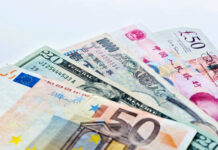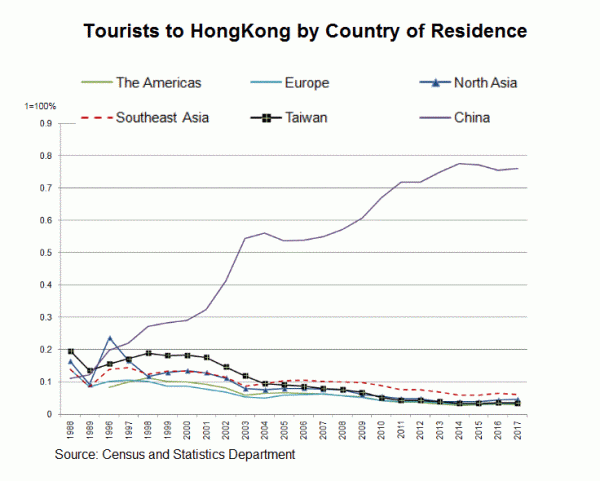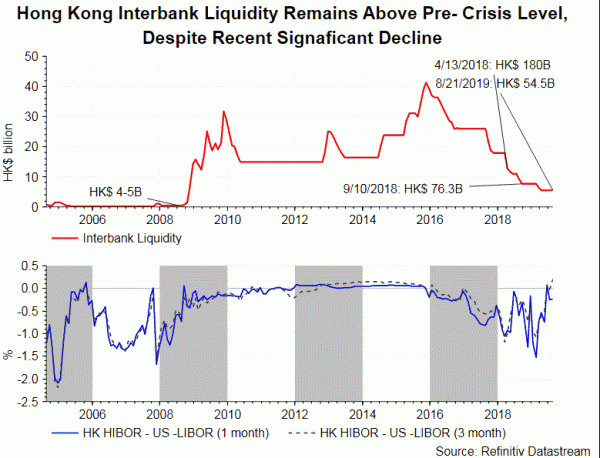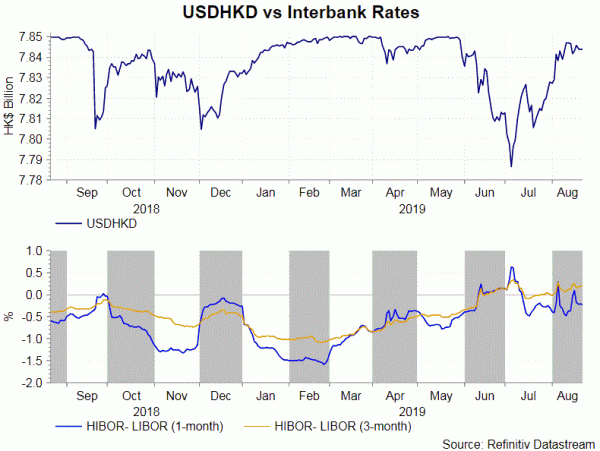Ongoing massive protests in Hong Kong against extradition to China have raised concerns about a rapid deterioration in the city’s economy and, more importantly, the collapse of the HKD-USD linked exchange rate system (LERS). This report suggests that the major reason for growth slowdown in Hong Kong is its over- reliance on China. Moreover, the status of HKMA’s Exchange Fund and FX reserve supports the resilience of the LERS.
Economic Slowdown Exacerbated by Over-Reliance on China
GDP growth contracted -0.4% q/q in 2Q19, following a +1.3% growth in the first quarter. Major weakness was seen in June. Retail sales contracted -6.7% y/y, after dropping -1.3% in May. On international trade, exports contracted -9% y/y, while imports were down -7.5%. As such, the government has also revised lower its GDP growth forecasts to 0-1% for this year, down from previous estimates of 2-3%.
Last week, Paul Chan, the financial secretary of Hong Kong announced a series of fiscal stimulus measures, worth of HK$ 19.1B (or 0.7% of GDP). Chan blamed protesters for blocking roads and important transport, including the international airport. He claimed that these are the major reasons, in addition to escalation of US- China trade war, for the acceleration of the city’s economic slowdown. Note, however, that the protests have only gained momentum since June 9, when about 1 million of the people took to streets. More aggressive actions followed later in the month when the government ignored the demands of the people and attempted to crack down the protests with violence. It is irrelevant to attribute the massive protests to the sharp decline in June’s retail sales and economic contraction in the second quarter.
Similar to other countries in the region, recent economic slowdown has been predominantly driven by US- China trade war. However, the impact has been amplified by the over-reliance of Hong Kong’s economy on China. Trading and logistics is the biggest pillar of Hong Kong’s economy, followed financial services, other professional services and tourism. Despite the consistent decline as China opens up and trades directly with global market, this sector still contributes to about 20% of the city’s economy. Lack of innovation, the sector heavily relies on handling re-exports between China and other countries. Compared with less than 40% before the handover in 1997, China is now Hong Kong’s largest trading partner, taking up 50% of the city’s total trade. Over- reliance on China has amplified the damage to Hong Kong’s economy amidst escalation of the trade war.
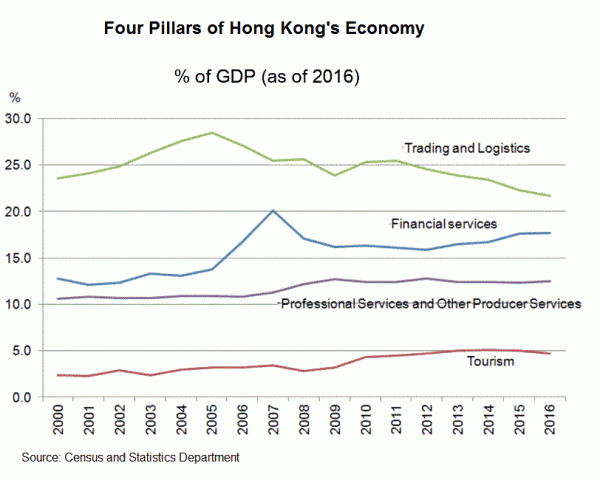
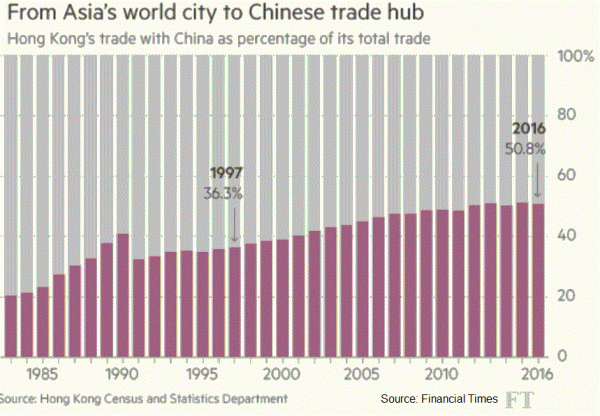 Tourism, together with related retail trade and catering services, takes up less than 5% of GDP. This is contrary to the propaganda that tourism is the lifeblood of Hong Kong.
Tourism, together with related retail trade and catering services, takes up less than 5% of GDP. This is contrary to the propaganda that tourism is the lifeblood of Hong Kong.
Despite warning recent protests have driven away tourists, the decline is more likely related to China’s economic slowdown, as tourists to Hong Kong come overwhelmingly from mainland China. After all, its real impact on the economy is limited.
Linked- Exchange Rate System Unlikely Shaken
Weakness of HK dollar over the past weeks has rekindled speculations of a potential breakdown of the peg with the US dollar. USDHKD spot has been hovering around the 7.85 level, above which the HKMA, the city’s de- facto central bank, would intervene by selling USD and buying HKD from the market directly. The 1y forwards traded slightly above 7.85 last week, before dropping to 7.84 today. Recent weakness has been driven by a confluence of factor of including weakness in Chinese economic date, depreciation in renminbi and the remote possibility that the trade war can be resolved in the medium term.
Nonetheless, HKMA should be capable to defend the peg. Under the LERS system, the Exchange Fund, operated by HMKA, has to hold more than sufficient USD assets to back the HKD monetary base at any time. The backing ratio is currently at 110%, while HKMA’s FX reserve holding is at US$ 448B, or 250% of the monetary base. Liquidity is entirely sufficient for intervention – selling USD and buying HKD should the 7.85 level is breached.
US- China trade war, weakness in Chinese economy together with domestic instability could trigger capital outflow, substantiating the volatility of USDHKD for some time. Yet, reduction in interbank liquidity will drive HIBOR higher while LIBOR should weaken amidst expectations of further reduction in Fed funds rates. Narrowing yield spread would lead USDHKD to drop in coming weeks, keeping the decades- long exchange system intact.

